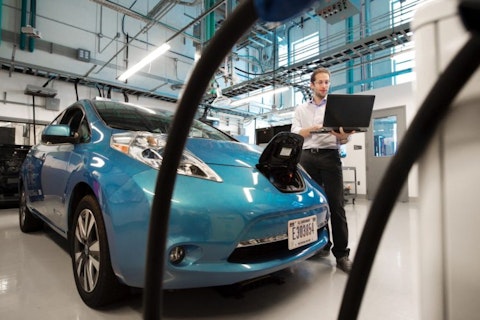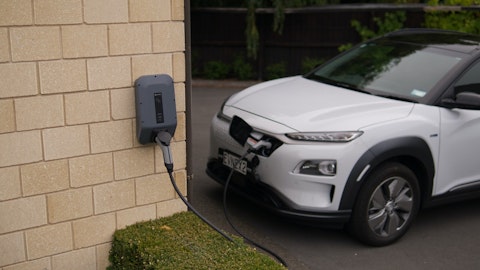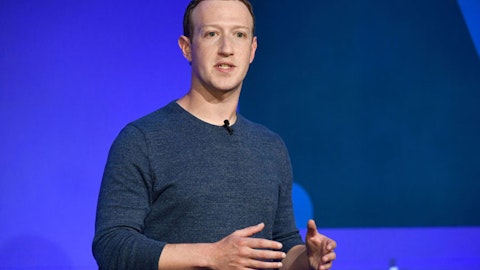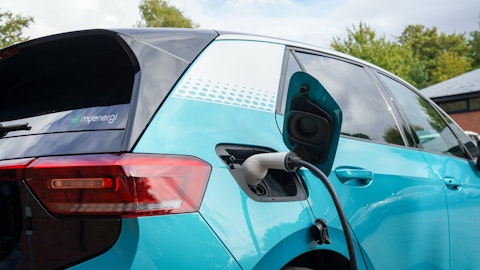ChargePoint Holdings, Inc. (NYSE:CHPT) Q2 2024 Earnings Call Transcript September 6, 2023
ChargePoint Holdings, Inc. beats earnings expectations. Reported EPS is $0.24, expectations were $-0.14.
Operator: Good afternoon, ladies and gentlemen. My name is Bo, and I’ll be your conference operator for today. At this time, I would like to welcome everyone to the ChargePoint’s Second Quarter Fiscal 2024 Earnings Conference Call and Webcast. All participant’s phone lines have been placed in a listen-only mode to prevent any background noise. After the speakers’ remarks, there will be a question-and-answer session. I would now like to turn the call over Mr. Patrick Hamer, ChargePoint’s Vice President of Capital Markets and Investor Relations. Patrick, please go ahead.
Patrick Hamer: Good afternoon, and thank you for joining us on today’s conference call to discuss ChargePoint’s second quarter of fiscal 2024 earnings results. This call is being webcast and can be accessed on the Investors section of our website at investors.chargepoint.com. With me on today’s call are Pasquale Romano, our Chief Executive Officer; and Rex Jackson, our Chief Financial Officer. This afternoon, we issued a press release announcing results for the quarter ended July 31, 2023, which can also be found on the Investors section of our website. We’d like to remind you that during the conference call, management will be making forward-looking statements, including our outlook for our third quarter and full fiscal year 2024.

science-in-hd-T2XeWHGZ7xU-unsplash
These forward-looking statements involve risks and uncertainties, many of which are beyond our control and could cause actual results to differ materially from our expectations. These forward-looking statements apply as of today, and we undertake no obligation to update these statements after the call. For a more detailed description of certain factors that could cause actual results to differ, please refer to our Form 10-Q filed with the SEC on June 8, 2023, and our earnings release, which posted today on our website as well as filed with the SEC on Form 8-K. Also, please note that we use certain non-GAAP financial measures on this call, which we’ve reconciled to GAAP in our earnings release and for certain historical periods in the investor presentation posted on the Investors section of our website.
And finally, we will be posting the transcript of this call to our Investor Relations website within the Quarterly Results section. With that, I’ll turn it over to Pasquale.
Pasquale Romano: Thank you, Patrick, and thank you all for joining us today. Before we get to the results for the quarter, I’d like to address four key points that are likely top of mind. First, we have announced the strategic corporate reorganization that we’ve been working on for months, with a goal of achieving higher operational efficiency as we scale, while reducing our operating expenses by an estimated $30 million on an annualized basis. As part of this reorganization, we’ve reduced our headcount by 10% and reducing our non-personnel expenses as well. Second, we’ve taken an inventory impairment charge on our first generation DC charging products. During the supply chain crisis, we saw the assurance of supply versus costs and are now adjusting our stranded costs to current values given inventory levels.
Third, let me address growth. We believe conversion of the world’s vehicle fleet to EVs remains inevitable as does the need for infrastructure to charge them. U.S. EV sales were up 48% year-over-year in Q2, a record for any quarter and Europe is experiencing a similar pace of adoption. Correspondingly, usage of our existing chargers on our network is up significantly. In short, this puts utilization pressure on infrastructure and we believe that will turn into demand for our products. Fourth, I’d like to underscore our continued commitment to positive adjusted EBITDA in Q4 of calendar 2024 and we believe we have sufficient cash for each to achieve that core objective. Moving on to Q2. We delivered revenue within our guidance range at $150 million, up 39% year-over-year and 16% sequentially, all done in an environment where many businesses are delaying discretionary spend.
In the U.S., we continue delivering on several major projects we have mentioned during previous calls. We are finishing construction of the Volvo-Starbucks project, a 1,300-mile corridor from Seattle to Denver, connected by ChargePoint DC fast charging solutions at Starbucks locations along the route. We also began shipping our charging stations for a much larger project is a Mercedes-Benz fast-charging network, which we announced at CES in January. As Mercedes recently stated, the first of these 400 plus charging hubs will open in the fall. In Q2, we also delivered a large amount of products to the United States Postal Service with our partner Rexel Energy Solutions, supporting the ongoing growth of our fleet business. Transit deployment scaled nicely in the quarter, including a project with the MTA in San Francisco, among others.
We’ve now over 18 — excuse me, 8,000 electric buses served by our charging management software and our telematic solutions. Just last week, we received a FedRAMP unique entity ID from the U.S. government, a designation achieved after a long process. This permits us to bid for tens of millions of dollars in potential U.S. government RFPs. I’d also like to reiterate our commentary on what is perceived as a major market development, adoption of the NACS connector. Seeing the market need to support this connector type, we began product development well ahead of the recent OEM announcements and are finalizing our NACS connector solutions to begin shipping in November. That being said, we remain committed to maintain — to making sure our customers do not need to dedicate parking spaces to cars equipped with a specific connector type.
Customers’ existing investments in ChargePoint technology are protected and will remain so into the future via an optional, cost effective upgrade program to NACS cables for their chargers. Our goal is to enable drivers to charge any vehicle anywhere, at any time. Turning to Europe. Our business continues to expand with a clear highlight being our collaboration with leasing companies. For those unfamiliar with the European car market, the majority of new vehicles sold are delivered as a leased company car benefit. During the quarter, we added Arval, a part of the BNP Group and a European leader in full service vehicle leasing, to the list of these companies that have chosen ChargePoint. With the same strategic lens through which we approach leasing company relationships, we also are fostering our partnerships with fuel card providers like WEX, UTA, Voyager and others.
These customers are building substantial charging businesses based on ChargePoint’s software. Overall, our European revenue grew 78% year-over-year and we have now surpassed 500,000 roaming ports for drivers there in addition to our own installations. Globally, we are progressing our fortified contract manufacturing strategy. We expect these changes to give us increased capacity and improved cost structure and reliable supply. Finally, to give you a snapshot of ChargePoint’s global momentum, here are our latest network, customer and environmental statistics. We finished the quarter with over 225,000 active ports under management, including more than 22,000 DC fast ports. Approximately one-third of our managed ports are in Europe, and we now provide drivers access to more than 532,000 roaming ports globally.
We count 76% of the 2022 Fortune 50, and 57% of the 2022 Fortune 500 as our customers. From an environmental perspective, as of the end of the quarter, we estimate that our network has now fueled approximately 7 billion electric miles, avoiding approximately 280 million cumulative gallons of gasoline and over 1.4 million metric tons of greenhouse gas emissions. And before I hand it over to Rex, I just want to correct one thing that I may have misspoken, we finished the quarter with 255,000 active ports under management. Apologize for the mistake. Rex, over to you.
Rex Jackson: Thanks, Pasquale, and good afternoon, everyone. As a reminder, please see our earnings release where we reconcile our non-GAAP results to GAAP and recall that we continue to report revenue along three lines, network charging systems, subscriptions and other. Network charging systems refer to our connected hardware. Subscriptions include our cloud services connecting that hardware; Assure warranties and our ChargePoint — sorry, connecting that hardware, Assure warranties and our ChargePoint-as-a-Service offerings where we bundle hardware, software and warranty coverage into recurring subscriptions. Other consists of professional services and certain non-material revenue items. For Q2, revenue was $150 million, up 39% year-on-year and 16% sequentially, within our guidance range of $148 million to $158 million.
Network charging systems at $115 million was 76% of Q2 revenue, up 36% year-on-year. Subscription revenue at $30 million was 20% of total revenue, up 48% year-on-year. Other revenue at $6 million and 4% of total revenue increased 51% year-on-year. Our deferred revenue continues to grow, this is future recurring subscription revenue from existing customer commitments and payments, and finished the quarter at $220 million, up from $205 million at the end of Q1. Turning to verticals. As you know, we report them from a billings perspective, which approximates the revenue split. Q2 billings percentages were commercial 75%; fleet 16%; residential 7%; and other 1%. Commercial was healthy and fleet continued execution against large programs. Despite the smaller contribution to Q2 billings relative to 24% in Q1, fleet grew over 50% year-on-year.
In residential, we saw demand building for our home products through dealer, retailer and utility programs. The shipments were slower than expected. From a geographic perspective, North America’s Q2 revenue was 79% and Europe was 21%, consistent with our first quarter of this year. In the second quarter, Europe delivered $32 million in revenue, grew 78% year-on-year and sequentially increased 17%. Turning to gross margin. Non-GAAP gross margin for Q2 was 3%. As Pasquale indicated, this reflects a $28 million or 19 margin point impairment to cost of goods sold. This was taken to address supply chain related higher component costs and supply overruns for our first generation DC charging products. In addition to this quarter end impairment, our non-GAAP gross margin for the quarter also included 3 points of headwind from selling this first generation product at the pre-impairment cost structure.
We see continued demand for this product. Non-GAAP operating expenses for Q2 were $89 million, a year-on-year increase of 11% and a sequential increase of 4%. From an operating leverage perspective, this represents a 6 point improvement against the first quarter. For reasons Pasquale mentioned, today, we took actions reducing our operating expenses. I will speak to the implications when I give guidance shortly. Stock-based compensation in Q2 was $35 million, up from $24 million in Q1. We typically do our annual refresh grants in Q2, which explains the stair step. Q2 non-GAAP adjusted EBITDA loss pre-impairment was $53 million. This was a 5% improvement year-on-year, but higher than our expectations due to revenue landing towards the low end of our range and a lower-than-expected gross margin.
Our non-GAAP adjusted EBITDA, inclusive of the impairment, was a loss of $81 million, 44% higher than last year’s second quarter. We continued to build inventory during the quarter. As mentioned last quarter, we are working through inventory associated with earlier supply commitments. We finished the quarter with $144 million in inventory, which is net of the Q2 impairment discussed earlier and up from $115 million at the end of Q1. We do not expect this level to increased significantly over the rest of this year. We are managing through these commitments and vectoring in on our turns goals. Looking at cash, we finished the quarter with $264 million in hand. This balance includes $38 million raised through our ATM program, which has generated a total of $105 million over the past three quarters.
During Q2, we also entered into a $150 million revolving credit facility, with four leading global banks. This facility is currently undrawn and provides non-dilutive liquidity. It will be strategically deployed alongside or at the market program to maintain a strong balance sheet as we drive towards becoming cash flow positive next year. This is our capital plan. We had approximately 360 million shares outstanding as of July 31, 2023. Turning to guidance. For the third quarter of fiscal 2023, we expect revenue to be $150 million to $165 million, up 26% year-on-year and up 5% sequentially at the midpoint. For the full fiscal year, we are guiding to $605 million to $630 million, up 32% year-on-year at the midpoint. Regarding gross margin, for the third quarter, we expect to be between 22% and 25% on a non-GAAP basis as we work through the inventory levels discussed earlier.
With the inventory issue behind us and aggressive programs for improving our cost structure on supply and manufacturing, we would expect to resume continued improvement in gross margin next year. Though we don’t typically guide on operating expenses, given the reorganization we announced today, we want to help reset everyone on a new level for the remainder of this year. Therefore, we expect non-GAAP operating expenses to be $81 million to $84 million in Q3, and $79 million to $82 million in Q4. Finally, regarding our goal of reducing our non-GAAP adjusted EBITDA by two-thirds from our Q1 level this year of $49 million, we are being prudent in our revenue guidance, while managing gross margin and operating expenses. Accordingly, we are targeting to have the Q1 adjusted EBITDA loss in Q4.
And with that, I’ll turn it back to Pasquale for closing remarks.
Pasquale Romano: Thanks, Rex. In summary, we delivered on our revenue guidance for the quarter and expanded operating leverage. We’re the clear leader in EV charging infrastructure across two continents and recognize that to be successful. Our solutions seem to be everywhere, easy to find, easy to use and highly reliable. ChargePoint is at the front of a long-term growth cycle. We are well-positioned and well-capitalized for the future, leaving us confident we will hit our goal of profitability on an adjusted EBITDA basis by the end of next year. Thank you for tuning in today. Operator, let’s proceed to questions.
See also 100 Most Popular Songs of All Time on Spotify and 15 Countries That Produce the Most E-waste in the World.
Q&A Session
Follow Chargepoint Holdings Inc. (NASDAQ:CHPT)
Follow Chargepoint Holdings Inc. (NASDAQ:CHPT)
Operator: Thank you. [Operator Instructions] We’ll take our first question this afternoon from James West of Evercore ISI.
James West: Hey. Good afternoon, guys.
Pasquale Romano: Hey, James.
Rex Jackson: Hey, James.
James West: Hey. So, Pat, you’re going to be shipping the new products here in a couple of months. I know you had already started to do engineering work and things like that. Is it going to cause a change at all in kind of the ASP for your products, or is it a relatively minor kind of adjustment just to add next to the existing portfolio?
Patrick Hamer: It doesn’t have an ASP, in fact.
James West: Okay. Got it. Thanks. And then maybe for Rex, on the 3 points of headwind on the margin, is that — I guess what are the main drivers of that? I believe it’s just the new — getting ready for the new sales. But are those just a this quarter issue? Do they go away in the next couple of quarters, or they’re here for the rest of the fiscal year?
Rex Jackson: So, James, those should go away going forward. It was an in-quarter item. We only flag it just because we did the impairments effective as of the end of the quarter. And therefore, it didn’t affect any of the underlying margin for that product during the quarter. We just want people to understand what the impact was. But with the impairment, that goes away.
James West: Right. Got it. Okay. Thanks, guys.
Operator: Thank you. We go next now to Colin Rusch at Oppenheimer.
Colin Rusch: Thanks so much, guys. With the restructuring, can you talk about areas where you’re going to focus some of those cuts, or is it really just generally across the board? And then the follow-up question is really about the pathway to the cash flow breakeven. If you could walk us through that, at the secondary question here.
Pasquale Romano: I’ll take the first part, Colin. So, I want to — I just want to make sure that something is well understood. We’ve been working on this restructuring for months and it’s quite distinct from many of the other financial parameters in the company. It does have some bearing on the back half of the year. But it’s largely something we’ve done as we’ve continued to optimize how we execute internally. And I’ll point out that over the last eight quarters or so, operating expenses have been operating in a fairly tight band and we’ve been improving operating leverage over that period of time. And so, to specifically answer your question, we made a restructuring a few weeks ago as Phase 1 of this, where we changed how we organize the go-to-market organizations with respect to North America and Europe due to scale just to improve our execution velocity and move some of the product portfolio organization closer to the regions to enable them to operate faster.
Today, we added to that some restructuring with respect to how we are organized in the R&D operations and product management organizations. We did quite a bit of consolidation and reorganization in those areas again from an execution perspective, it will improve our velocity. And then we also did some things in other areas of the company across sales and marketing and G&A in addition to those, where we did address reducing some of the OpEx on a go-forward basis. So, it’s really a combination of all of the above. Hope that answers your question.
Colin Rusch: That’s super helpful. And then the follow-up question is really just what I asked. The pathway to get into the cash flow breakeven looks like kind of at midpoint, you’re about $180 million in revenue for the fourth quarter, plus or minus. And so, thinking about a 30% to 35% growth rate, and — would require substantial margin expansion. And I just wanted to get a sense of how you guys see that path moving forward to getting into the 30% to 35% gross margin range?
Rex Jackson: Yeah. So, good work on the model. Bottom line is we’ve declared again today that we’re bound and determined to get to that results by the — by Q4 of next year. I think the reorganization we did today is an indication of our commitment to that target. If you run the numbers, yeah, there needs to be some gross margin improvement. I think I alluded to that in my commentary. We’ve got some short-term things that we need to grind through from a, call it, the supply chain hangover standpoint, which we will do. But again, I think, we’ve shown consistently from an execution standpoint that we can generally hit our top-line guidance and we’re bound and determined to hit that target in Q4.
Colin Rusch: Okay. Thanks so much guys.
Operator: We’ll go next now to Matt Summerville at D.A. Davidson.
Matt Summerville: Thanks. Couple of questions. First, Pat, on your prepared remarks, you mentioned the qualification you received from the U.S. government. What’s involved in that qualification and what distinguishes your ability to compete on some of these deals versus others in the market?
Patrick Hamer: Yeah. So, as a point of clarification, that is a — the FedRAMP is largely centered around the federal governments internal — or controls requirements on software systems that are controlling assets that are sold to the federal government in certain agencies. It’s one of the qualification programs. Receiving that ID is — and being listed on the website basically is the milestone that effectively says we’ve been through all of the process at the federal government with respect to meeting the controls and audit requirements that they have across the board. So, think about it as control, security, other things associated largely with software. And remember, for us, we always lead with those with a software-first approach and that pulls through obviously the hardware that we have that works in conjunction with that software to deliver the entire solution.
Matt Summerville: Got it. And then just a quick follow-up. I think you guys have been doing some belt tightening ahead of this formal cost out program. So, when you think about it holistically, is that $30 million number actually higher in terms of OpEx take-outs? And when do you expect to hit that $30 million run rate? What would be the timing on that? Thank you.
Rex Jackson: Yeah. So, the $30 million is an annualized number. We pulled the trigger today. Today is the reorder took effect today. What you’ll see is, in Q3, you will see some impact of that, hence my guidance for Q3 OpEx. The full impact of it will hit in Q4, because obviously today is September — whatever today is September 5th — 6th, thank you. So, we don’t get the full impact in Q3, we’ll get the full impact in Q4, and then obviously that’s again that keeps on giving as we move into next year. And, I think, the main thing that people should focus on is, if you look at what we’ve been doing, I think we’ve been pretty responsible in terms of managing our operating expenses. We added some acceleration back in calendar ’21, we leveled out in ’22, had some exploration beginning of the year, but recognized to hit some of the profitability targets that we put out, we needed to ratchet back.
But we’ve actually done a great job I think of significantly expanding the top-line while holding the operating expense level really constant, net-net. And so, we feel confident that we’re going to get to our targets next year.
Matt Summerville: Thanks, Rex.
Operator: Thank you. We’ll go next now to Alex Vrabel at Bank of America.
Alexander Vrabel: Thanks for taking my question, guys. Maybe just a higher level. And I think you mentioned at the outset, talking about sort of utilization on the infrastructure portends sort of more demand to come. I’m just curious, right, there’s a lot of sort of noise out there about EV sitting on lots. I think fleet EVs are still relatively delayed around backlog. You guys obviously have a broad scope and a broad view. So, just curious how you would sort of paint the real picture from what you’re seeing out there and how things have evolved sort of from the start of the year to today? Thanks.
Pasquale Romano: Yeah. So, let me take your two part question kind of backwards. On the fleet side, definitely vehicle limited, very consistent with the comments that I’ve made on previous earnings calls. So, continuing to win customers just sets us up for an expand later when that starts to de-compress. And from a customer base perspective, I think, if you pulled large fleet customers, they would express some frustration with respect to the availability of vehicles. On the passenger car side, while there are some makes and models that are moving. I think what you’re seeing is some price sensitivity in the consumer market with respect to the higher priced side of the electric vehicle market in general, and probably the vehicle market overall, given where interest rates are.




